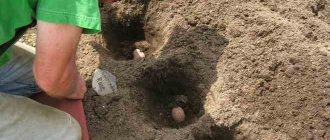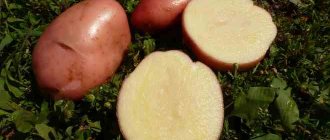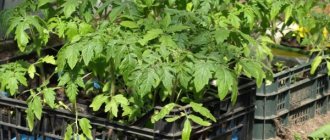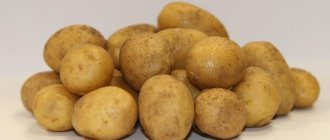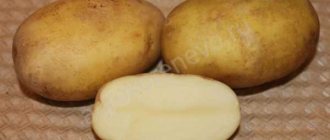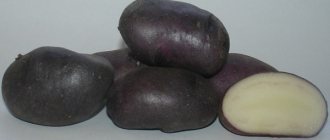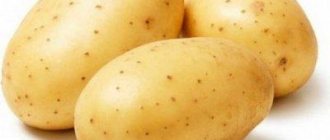Description of the variety Cornflower
| Variety name | cornflower |
| general characteristics | table variety from the Russian collection, with purple tubers |
| Maturation period | 80-100 days |
| Starch content | 12-16% |
| Weight of marketable tubers | 80-120 gr |
| Number of tubers in a bush | 9-14 |
| Productivity | 200-480 c/ha |
| Consumer qualities | suitable for dietary nutrition |
| Keeping quality | 96% |
| Peel color | violet |
| Flesh color | white |
| Preferred Growing Regions | Central |
| Disease resistance | susceptible to potato nematode, moderately resistant to viruses, late blight of tops and tubers, scab, resistant to potato cancer |
| Features of cultivation | standard agricultural technology |
| Originator | VNIIKH them. A.G. Lorkha (Russia) |
- Ripening time 70-90 days (medium early).
- Table variety.
- Used in dietary and baby food.
- Contains a large amount of vitamins C, E.
- The variety is especially valuable for the presence of carotenoids in the tubers.
Carotenoids are organic natural pigments formed during photosynthesis. They act as antioxidants in the human body.
Antioxidants normalize the functioning of the reproductive organs, skin, and mucous membranes. Protect the body from fungal and bacterial diseases.
- Culinary type VS. Designed for making soups, purees, boiling and frying.
- The taste is excellent.
- Average starch levels in the variety are 12.6-16%.
- The potential marketable yield of the variety is medium-high . The maximum achievement in the Moscow region is 182 centners of potatoes per hectare.
- Has excellent keeping quality, not lower than 96%.
- The marketability of the variety is 70-94%.
- Average sensitivity of the variety to mechanical stress.
According to clinical studies conducted in American clinics, eating purple potato dishes prevents the development of cancer , the formation of cholesterol plaques, strengthens blood vessels and supports the heart muscle.
In the table below you can get acquainted with such indicators as the keeping quality and yield of potatoes of different varieties:
| Variety name | Productivity | Keeping quality |
| cornflower | up to 180 c/ha | 96% |
| Bullfinch | 180-270 c/ha | 95% |
| Rosara | 350-400 c/ha | 97% |
| Molly | 390-450 c/ha | 82% |
| Luck | 420-430 c/ha | 88-97% |
| Latona | up to 460 c/ha | 90% (assuming there is no condensation in the storage) |
| Kamensky | 500-550 | 97% (early germination at storage temperatures above +3°C) |
| Impala | 180-360 | 95% |
| Timo | up to 380 c/ha | 96%, but the tubers germinate early |
Potatoes of this variety keep well. Read more about timing, temperature and storage problems. And also about how to store root vegetables in winter, on the balcony, in boxes, in the refrigerator, peeled.
Farmer reviews
Although the Cornflower variety is new, it has many positive reviews from farmers and gardeners.
Tatyana, Ryazan: “Cornflower is similar to the Blue Danube and Tsyganka varieties. A little small, but there are a lot of potatoes in the bush. Disadvantage: affected by scab.”
Irina, Kursk: “I planted Cornflower, Golubizna, Kolobok and Charodey on the plantation. Cornflower gave the largest harvest (0.5 kg yielded 12–15 kg). I don’t really like that the variety gets a little soft when cooked.”
Nina, Nizhny Novgorod: “Cornflower potatoes do not like overly alkaline or acidic soil. To determine if the soil acidity is suitable for growing this variety, pay attention to the weeds growing in the area. If dandelions with coltsfoot and wheatgrass bloom profusely on the plantation, you can safely plant Cornflower. It will feel great in such land and will produce a good harvest.”
Characteristics
- Bush of medium height, intermediate semi-erect type.
- The open, dark green leaves are medium in size. The tops are strong, rich green in color;
- Corolla of small red-violet or bluish-violet flowers;
- Anthocyanin coloration on the inside is weak to medium.
Anthocyanins are natural coloring substances. Flowers, peel and pulp of fruits are colored blue, purple, and red. - The peel is glossy, distinct purple in color, very beautiful.
- The average weight of a marketable tuber is 77-115g. One bush brings up to 15 tubers.
- The pulp is white, creamy when cut. The consistency is dense, soft, medium mealy and watery.
- When heat treated, the purple color of the peel disappears.
- The eyes are small and superficial.
- The seed material is dark brown with a blue tint. Sprouts of rich purple color.
You can compare this indicator of the number of tubers with that of other varieties using the table below:
| Variety name | Number of tubers in a bush |
| cornflower | up to 15 |
| Jelly | up to 15 |
| Typhoon | 6-10 pieces |
| Lily | 8-15 pieces |
| Tiras | 9-12 pieces |
| Elizabeth | to 10 |
| Vega | 8-10 pieces |
| Romano | 8-9 pieces |
| Gypsy | 6-14 pieces |
| Kolobok | 15-18 pieces |
Photo
The photo shows the Cornflower potato variety:
Photo: Natalya Smirnova, the editors thank you for permission to use the photo.
Disease resistance
- High degree of resistance of the variety to late blight of leaves and tubers, potato cancer;
- Not susceptible to wrinkled rot, banded mosaic;
- Weakly affected by ring rot, dry rot, and common scab;
- The variety is susceptible to potato cyst nematode.
Features of potatoes
The elastic tubers, uniform in shape and size, are convenient for harvesting and storage. The presence of carotenoids can be noted.
Origin
Potato Vasily is the fruit of five years of work by Russian scientists. It was obtained by crossing the Chugunka variety and the hybrid D-31-88. Registered in the register of the Russian Federation as a selection achievement in 2014 under No. 9253214.
The developer, originator, and patent holder of the Vasilek potato variety is the All-Russian Research Institute of Potato Farming (VNIIKH) named after. A. G. Lorch of the Russian Agricultural Academy.
The variety is recommended for cultivation in the Central, Central Black Earth, and Northwestern regions of Russia on private farms.
Research has shown that colored tubers absorb less nitrates than traditionally colored varieties. At the same time, the percentage of starch and proteins does not decrease and the saturation of vitamins is increased.
Two medium colored potatoes contain as much vitamin C as one lemon.
Harvest storage
The tubers are transferred to the cellar after they have dried and been sorted. Planting material for next year is selected in the fall, so it must be placed in a separate box.
In the cellar, potatoes can be stored in wooden or polymer boxes. At the same time, you should not place the boxes close to the walls, since such placement will impair aeration and evaporation of excess moisture, which leads to rotting of root crops.
It is necessary to periodically inspect the tubers for rot. If there are several rotten potatoes in the box, they must be disposed of immediately. Otherwise, massive crop decay may begin.
Agricultural technology
Agricultural technology for growing Cornflower potatoes includes several main points.
Seed selection
To prevent potato nematode diseases, it is important to prepare high-quality seed material .
- For planting, healthy, smooth tubers without growths or damage weighing 50-75 g are selected;
- Spray the tubers with an aqueous solution of copper sulfate (a tablespoon per bucket of water);
- Dry, lay out in the light in one layer for germination.
Soil and site
Potato variety Cornflower prefers sunny areas, protected from strong draft winds. To provide the seedlings with optimal temperature and breathable conditions, the soil for planting is dug up twice - in autumn and spring.
To make heavy soils suitable for growing Cornflower potatoes, a lot of organic matter is added to them.
In swampy-peaty soils, the variety produces a harvest only after cultivation and reclamation work has been carried out.
Follow the rule of crop rotation. The variety is planted after growing green manure, root crops, cabbage, cucumbers, pumpkin and legumes.
Seed material, depending on the weight of the tubers, is planted according to the following schemes: 70x20 cm, 60x25 cm, 60x30 cm.
Green manures are plants that improve the quality and structure of the soil, enriching it with nutrients and organic substances. The most suitable green manures for potatoes are alfalfa, peas, vetch, and sweet clover.
Care instructions
- On days 14-15 after planting, the row spacing is loosened to a depth of 8 cm;
- When the tops reach a height of 15 cm, the first hilling is carried out. After the disappearance of the gaps between the overgrown bushes - the second;
- In dry weather, three waterings are required during the active growth period. Consumption of up to 3 liters of water per bush;
- Weed or mulch regularly.
Agrotechnical rules
If we consider the Cornflower variety from an agrotechnical point of view, it is a fairly easy-to-grow potato that does not require special knowledge or special attention from the summer resident. However, if you carry out planting work correctly and take good care of Cornflower, then it will respond to all this with a good harvest.
Basic agrotechnical rules for growing potatoes:
The quality of the harvest will depend on the quality of planting material. Therefore, only healthy tubers are allowed for planting. They should not be covered with stains, cracks, growths or insect holes. Experienced summer residents recommend treating root crops with special pesticides before planting to prevent possible invasion by insects or fungal diseases. In the fall, after harvesting, it is necessary to prepare the soil. To do this, weeds are completely removed from the site, it is plowed/dug up and fertilizer is applied. Tubers can only be planted in well-warmed soil. The ideal soil temperature for planting is +8-10 degrees Celsius. At lower soil temperatures, the crop will develop very poorly and there is a risk of death of the seed material. Potatoes should not be planted too crowded. The ideal distance between rows is 70 cm, between holes 35-40 cm. The larger the row spacing, the better the aeration and illumination of the bushes
Also, the greater the distance between the rows, the easier it is to hill up the bushes. You need to pay special attention to watering. Cornflower is not a demanding variety, but it needs to be watered at least three times during the season.
The first time is when the first shoots appear (grow up to 10 cm). The second time in the active flowering phase. After the flowers appear, 2-3 liters of water are consumed per 1 potato bush. And the last watering is carried out immediately after flowering. Since Cornflower is a mid-season variety, it is not watered after flowering in order to protect the crop from possible late blight invasion. It is imperative to carry out hilling. Firstly, if you do not hill up the potatoes, you can lose 20-30% of the harvest, since additional stolons are not formed. Secondly, during hilling, weeds are removed and the soil is loosened.
Prevention of diseases and feeding
In order to prevent late blight, the variety is treated with copper-containing preparations three times during the growing season.
As for fertilizers, after planting they are fed with a 10% solution of bird droppings, a solution of urea (a tablespoon per bucket of water), manure (a liter jar of manure per bucket of water), and herbal infusions.
Read more about how to feed potatoes, when and how to apply fertilizers, and how to do it correctly when planting.
To combat Colorado potato beetles and fertilize, place a handful of wood ash mixed with soil into the holes during planting.
To destroy larvae and beetles, ash-wormwood tincture is used.
- Grind 3-4 handfuls of fresh wormwood;
- Pour boiling water over;
- Add a glass of ash;
- Stir, let it brew for 3-4 hours, filter;
- Spray in the morning or evening.
In addition to fertilizers, other preparations and chemicals are often used when growing potatoes. We bring to your attention useful articles about the benefits and harms of fungicides and herbicides.
Despite the young age of Cornflower potatoes, they are already loved for their taste , dietary properties and beauty of the tuber . It continues the color line of the popular blue and purple varieties.
How to care for potatoes
Alvara's care is standard. It includes watering, fertilizing, loosening, weeding, hilling and preventive treatment.
Irrigation mode
The Alvara potato variety is drought resistant. It does not need frequent watering; it is enough to do it several times a season, more often in the southern regions. The signal for irrigation is when the soil dries out by 6–8 cm. In wet weather there is no need to water.
Although Alvara is watered rarely, it is plentiful. In hot summers, you may need half a bucket of water for each adult bush.
It is very important that plants are hydrated during flowering and tuber formation.
Feeding
Potatoes growing on fertile soil and fertilized during planting do not need further feeding.
But if there is a need, you can feed it during the growing season:
- during the growth of greenery - nitrogen mineral fertilizer (urea solution) or organic (mullein or chicken manure solution);
- during the budding period, before the start of flowering - phosphorus-potassium fertilizer (superphosphate with potassium sulfate and wood ash).
We recommend that you learn what and how to properly process potatoes.
Next, you can apply foliar feeding by spraying the bushes:
- after the start of flowering - a solution of ammonium nitrate, superphosphate and potassium chloride;
- during the growth of root crops - with a special fertilizer "Mag-Boron", containing magnesium and boron, which improve the taste and density of tubers.
Weeding and loosening the soil
The first loosening of the soil should be carried out even before the emergence of seedlings, about a week after planting. This measure will ensure air access to the planted seeds. You can loosen the soil while simultaneously removing germinating weeds with a rake or harrow.
Subsequently, these operations are carried out the next day after each watering and rain. Don't forget about hilling. The first time plants are 15–20 cm high, and again after 2 weeks. But in the southern regions, where there is little moisture in the ground, there is no need to hill up the bushes.
Read more about why hilling potatoes is needed.
Preventive treatment against diseases and pests
Alvar potatoes have strong immunity. Of all potato diseases, only late blight is susceptible.
Prevention from the disease is the following steps:
- compliance with crop rotation;
- planting only germinated seeds;
- treatment with special preparations before planting;
- compliance with the correct planting scheme so that the bushes are well ventilated and illuminated;
- in humid weather favorable for late blight, preventive spraying with fungicides (copper oxychloride, Modex, Azocene 5%, Polycarbacin 80%, Arcerid 60%).
The most dangerous pest is the Colorado potato beetle. Old and young individuals can destroy a potato planting in a few days. A preventive measure is to treat the tubers before planting. And you can fight the beetles that have already appeared by spraying the bushes immediately after the larvae hatch. Insecticides used: “Prestige”, “Aktara”, “Regent”, “Korado”.
Important! The last spraying with chemicals should be carried out no later than 20 days before harvest
Useful video
In the table below you will find links to materials about potatoes with different ripening periods:
| Mid-season | Mid-early | Mid-late |
| Santana | Tiras | Melody |
| Desiree | Elizabeth | Lorch |
| Openwork | Vega | Margarita |
| Purple Haze | Romano | Son |
| Yanka | Lugovskoy | Lasunok |
| Tuscany | Tuleevsky | Aurora |
| Giant | Manifesto | Zhuravinka |
If you find an error, please select a piece of text and press Ctrl+Enter.
